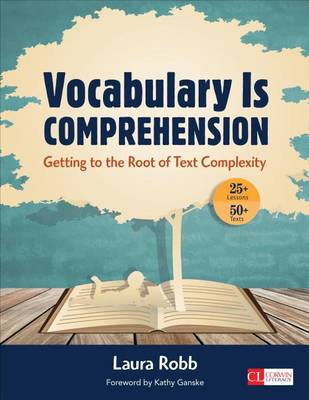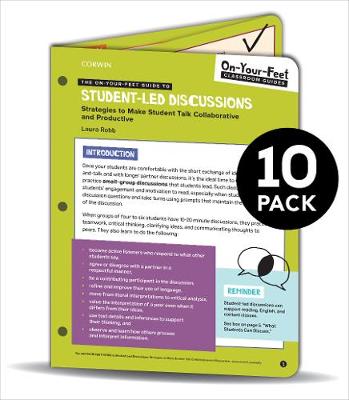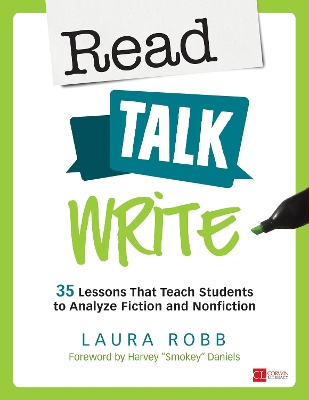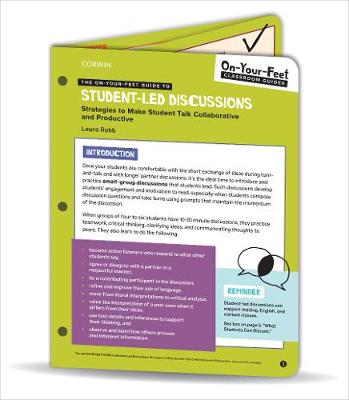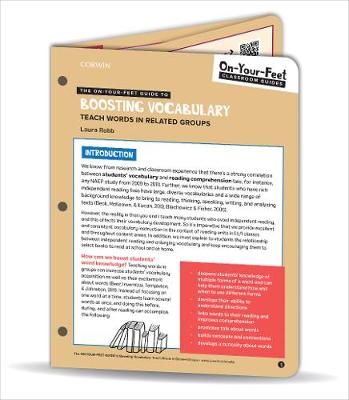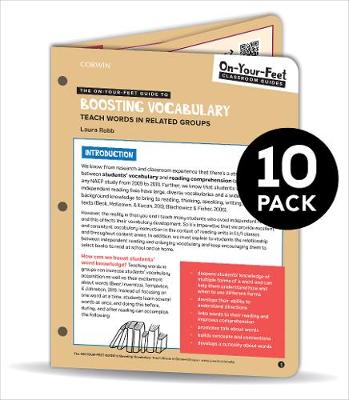Corwin Literacy
7 total works
BUNDLE: Robb: The On-Your-Feet Guide to Student-Led Discussions: 10 Pack
by Laura J. Robb
All On-Your-Feet Guide orders receive FREE SHIPPING! Use code SHIPOYFG at check out.
Once your students are comfortable with the short exchange of ideas during turn-and-talk and with longer partner discussions, it's the ideal time to introduce and practice small group discussions that students lead. Such discussions develop students' engagement and motivation to read especially when they compose discussion questions and take turns using prompts that maintain the momentum of the discussion.
When groups of four to six students have 10-20 minute discussions, they practice teamwork, critical thinking, clarifying ideas and communicating them to peers. They also learn to:
- Become active listeners who respond to what other students say;
- Agree or disagree with a partner in a respectful manner
- Be a contributing participant in the discussion
- Refine and improve their use of language
- Move from literal interpretations to critical analysis
- Value the interpretation of a peer even when it differs from their ideas
- Use text details and inferences to support their thinking
- Observe and learn how others process and interpret information
On-Your-Feet Guides (OYFGs) provide you with the ultimate "cheat sheet" to implement effective change in your classroom while in the moment of teaching. Designed for accessibility, and providing step-by-step guidance, the OYFGs are written by experts who take research-based practices and make them doable for the busy teacher.
Each On-Your-Feet Guide is laminated, 8.5"x11" tri-fold (6 pages), and 3-hole punched.
Use the On-Your-Feet Guides
* When you know the "what" but need help with the "how"
* As a quick reference to support a practice you learned in a PD workshop or book
* To learn how to implement foundational practices
* When you want to help your students learn a specific strategy, routine, or approach, but aren't sure how to do it yourself
What happens when students compose discussion questions and take turns maintaining the momentum of a discussion? Deeper engagement, motivation, and collaboration.
Student-led discussions allow students to practice teamwork, critical thinking, clarifying ideas and communicating them to peers. They become active listeners, refine and improve their use of language, and develop higher order analysis, synthesis, and inference skills.
This On-Your-Feet Guide will help teachers:
* Create a structure for effective student-led conversations
* Focus on specific strategies that increase engagement and participation
* Generate essential questions that lead to deeper discussions
* Deliver prompts for keeping discussions moving forward
* Trouble-shoot and scaffold learners through specific conversational "tricky spots"
Use this on-your-feet guide to coach your students toward meaningful discussions that enhance literacy learning and increase engagement.On-Your-Feet Guides (OYFGs) provide you with the ultimate "cheat sheet" to implement effective change in your classroom while in the moment of teaching. Designed for accessibility, and providing step-by-step guidance, the OYFGs are written by experts who take research-based practices and make them doable for the busy teacher. Each On-Your-Feet Guide is laminated, 8.5"x11" tri-fold (6 pages), and 3-hole punched.
Use the On-Your-Feet Guides
- When you know the "what" but need help with the "how"
- As a quick reference to support a practice you learned in a PD workshop or book
- To learn how to implement foundational practices
- When you want to help your students learn a specific strategy, routine, or approach, but aren't sure how to do it yourself
We know from research and classroom experience that there's a strong correlation between students' vocabulary and reading comprehension...but we also know that many students, especially in middle grades, avoid independent reading. So, it's imperative that we provide consistent vocabulary instruction in ELA classes and throughout content areas.
Teaching words in related groups can increase students' vocabulary acquisition as well as their excitement about words. Plus, learning words in related groups improves comprehension, builds concepts and connections, and deepens student's knowledge of how and when to use different forms of a word.
This On-Your-Feet Guide will help teachers:
* Understand the connection between vocabulary and comprehension
* Focus on one doable, replicable, everyday strategy for teaching specific words in related groups
* Differentiate instruction based on students' needs
* Trouble-shoot and scaffold learners through specific vocabulary learning snags
Use this guide to get kids talking and thinking about words - which leads to much deeper learning than rote-memorization lists.
On-Your-Feet Guides (OYFGs) provide you with the ultimate "cheat sheet" to implement effective change in your classroom while in the moment of teaching. Designed for accessibility, and providing step-by-step guidance, the OYFGs are written by experts who take research-based practices and make them doable for the busy teacher. Each On-Your-Feet Guide is laminated, 8.5"x11" tri-fold (6 pages), and 3-hole punched. Use the On-Your-Feet Guides
- - When you know the "what" but need help with the "how"
- - As a quick reference to support a practice you learned in a PD workshop or book
- - To learn how to implement foundational practices
- - When you want to help your students learn a specific strategy, routine, or approach, but aren't sure how to do it yourself
BUNDLE: Robb: The On-Your-Feet Guide to Boosting Vocabulary: 10 Pack
by Laura J. Robb
All On-Your-Feet Guide orders receive FREE SHIPPING! Use code SHIPOYFG at check out.
We know from research and classroom experience that there's a strong correlation between students' vocabulary and reading comprehension (see, for instance a NAEP study from 2009-2011. Further, we know that students who have rich independent reading lives have large, diverse vocabularies and a wide range of background knowledge to bring to reading, thinking, speaking, writing, and analyzing texts (Beck, McKeown, and Kucan, 2013; Blachowicz and Fisher, 2006).
However, the reality is that you and I teach many students who avoid independent reading, and this affects their vocabulary development. So it's imperative that we provide excellent and consistent vocabulary instruction in the context of reading units in ELA classes and throughout content areas. In addition, we must explain to students the relationship between independent reading and enlarging vocabulary and keep encouraging them to select books to read at school and at home.
How can we boost students' word knowledge? Teaching words in groups can increase students' vocabulary acquisition as well as their excitement about words (Bear, Invernizzi, Templeton, and Johnston, 2011). Instead of focusing on one word at a time, students learn several words at once, and doing this before, during, and after reading can:
- Deepen students' knowledge of multiple forms of a word and can help them understand how and when to use different forms
- Develops their ability to understand directions
- Links words to their reading and improves comprehension
- Promotes talk about words
- Builds concepts and connections
- Develops a curiosity about words
On-Your-Feet Guides (OYFGs) provide you with the ultimate "cheat sheet" to implement effective change in your classroom while in the moment of teaching. Designed for accessibility, and providing step-by-step guidance, the OYFGs are written by experts who take research-based practices and make them doable for the busy teacher.
Each On-Your-Feet Guide is laminated, 8.5"x11" tri-fold (6 pages), and 3-hole punched.
Use the On-Your-Feet Guides
- When you know the "what" but need help with the "how"
- As a quick reference to support a practice you learned in a PD workshop or book
- To learn how to implement foundational practices
- When you want to help your students learn a specific strategy, routine, or approach, but aren't sure how to do it yourself
